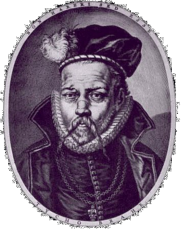Not every astronomer was quick to accept the new heliocentric theory. Tycho Brahe never was convinced of the
possible orbital motion of Earth. Tycho gained noteriety by his discovery of a new star, or nova, in the constellation of
Cassiopeia as well as a bright comet. The King of Denmark was so impressed by his early observations that he gave
Tycho the equivalent of a few million dollars and his own private island. On that island, he built the first real research
institute and the observatory called Uraniborg. To support his modified geocentric system, Tycho made incredibly
accurate observations with a number of different instruments, including his mural quadrant. These measurements of the
positions of planets and stars were made at his observatory on the island of Hven They were typically made to within
one minute of arc, Today, there is a museum dedicated to Tycho on the island.
In his studies of heavenly bodies, Tycho failed to detect any apparent motion of the stars, or parallax These hundreds of
observations led him to that incorrect conclusion that the Earth could not be moving through space. Since a lack of parallax in his
observations convinced him of a stationary Earth, he devised an interesting hybrid system where the Earth was stationary.
If we have time, we’ll hear the story of Tycho’s lost nose and his pet moose. And.. How did Tycho, in fact, meet his end?





















